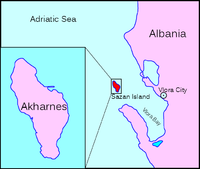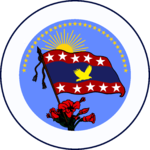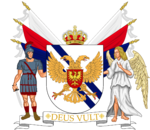Federal Republic of Akharnes
This article refers to a micronation or element of micronationalism which is defunct and no longer exists. You can help make the article reflect that or ask on the talk page for further information. |
| |||||||||
|---|---|---|---|---|---|---|---|---|---|
| Anthem: Прощание Славянки! (Proschaniye Slavyanki) | |||||||||
 Location of Akharnes | |||||||||
| Capital | Džoltovolk | ||||||||
| Official languages | Mirolian, Russian, English, Greek | ||||||||
| Demonym(s) | Akharnian, Mirolian | ||||||||
| Government | Federal Presidential Constitutional Republic | ||||||||
• President | Edward Jacobs | ||||||||
• Vice President | Hasan Çakar | ||||||||
| Legislature | National Congress | ||||||||
| Establishment | July 7th, 2011 | ||||||||
| Population | |||||||||
• Census | 8 | ||||||||
| Currency | Ashukov Denar | ||||||||
| Time zone | GMT +2 | ||||||||
Website Government Website | |||||||||
| |||||||||
Akharnes, officially the Federal Republic of Akharnes (Russian: Федеративная Республика Ахарнес), is a small European State of the Ashukov Federation, claiming a 2,2 sq. miles large island near Albania. Originally founded in 2011 as the Slavania Republic, it was renamed into the Principality of Akharnes a year later. A former constituent nation of the Confederation of Saint Luke and Amager (December 2012 - April 2013), Akharnes adopted a Republican form of government a few months before founding the Ashukov Federation on May 25, 2013.
Etymology
Akharnes was originally founded as a nation for Slavic people, hence its old name "Slavania". Its current name of "Akharnes" was inspired from an Athenian suburb called Acharnai.
History & Statehood
The independence of Slavania Republic was declared on July 7, 2011. On July 9, 2012, it was renamed into the Principality of Akharnes and in early 2013 the nation was reformed into a Republic. Slavania Republic based its independence on the Montevideo Convention on the Rights and Duties of States, which sets out the definition, rights and duties of statehood. Most well-known is article 1, which sets out the four criteria for statehood:
The state as a person of international law should possess the following qualifications:
- a permanent population;
- a defined territory;
- government;
- capacity to enter into relations with the other states.
Furthermore, the first sentence of article 3 explicitly states that "The political existence of the state is independent of recognition by the other states."
The Establishment (July 2011 - November 2012)
Akharnes, then known as Slavania, was founded by Edward Jacobs, who was later joined by Marko Damjanović. The main purpose for founding a micronation was the promotion of Pan-Slavism, of which Jacobs was a big supporter. From the first day of its founding, Akharnes proved to be a nation with an extremely peaceful and almost isolated foreign policy to the extent of having little contact with other micronations. However, in July 2012, Akharnes set up its own Ministry of Foreign Affairs with Marko Damjanovic and Edward Jacobs as its leaders. Within the next few months, Akharnes signed over 20 treaties of mutual agreement and co-operation and made even more informal allies, which led Akharnes to become a notable member of the micronational community.

After more than a year of statehood, came the period of inactivity and poor governmental control. The number of citizens was constantly dropping, which made the government think about Akharnes' future and disestablishing the Republic was among the possible outcomes. Nonetheless, Edward Jacobs took all the necessary steps to prevent such, and as a result, instead of becoming defunct, on December 1, 2012 Akharnes joined the Confederation of Saint Luke and Amager.
The Amagerian Era (December 2012 - April 2013)
Akharnes was the first Slavic nation to join Amager. The beginning of Akharnes' integration was marked with several confusions and misunderstandings with the Federal Assembly, however by January 2013, Akharnes concluded its full integration and in February, Edward Jacobs took over the Conservative (National) Party of Amager.
On April 6, 2013, following Doshevika's declaration of independence, the Confederation of Amager was dissolved by the Federal Assembly and Akharnes re-gained its full sovereignty.
Ashukovo (May 2013 - October 2014)
On May 25, 2013 Akharnes joined Montania, Dorién and Dradelia to found the Ashukov Federation. Since then, the Akharnian government declined in activity, with all regional representatives setting a primary focus on Ashukov matters.
Upon the transformation of Ashukovo into a Tsardom, Akharnes merged with its longstanding ally the Republic of Somster to form the Orthodox Grand Duchy of St. Konstantin.
Government and Politics
The Federal Republic of Akharnes is a region with a republican form of government. Legislative power is exercised by the National Congress of Akharnes. Executive power, however is in the hands of the President. People elect a President who serves a term of five years. The National Congress members are appointed by the elected Head of State and cannot be removed until he is in office. The President also appoints Ministers (known as Heads of Departments) and Mayors. Akharnes does not have a separate head of government. This position is de facto held by the President, although it can be transferred to the Vice-President for a certain amount of time by a Presidential decreee if needed.
Political Parties
Akharnes is a three-party State, with the National Party (NP) playing the key political role.
| Party | Founded | Ideology | Leader |
|---|---|---|---|
| 2013 | Centrism, Statism, Pan-Slavism, Patriotism | Edward Jacobs | |
| 2013 | Environmentalism, Grassroots Democracy | Vacant |
Geography
Sazan Island
Akharnes' main claim is located on the Sazan Island off the Albanian coast. The 5.7 km2 island has previously served as a German military base in World War II, as a Soviet base during the rise of Communism in Albania and today it is a shared Italian-Albanian military base used for patrolling and tracking illegal immigration. Sazan Island can be seen from the city of Vlorë.
Kaldaria
Akharnes is a member of the Antarctic Micronational Union and claims land on the East Coast of Antarctica, called Kaldaria. It is currently the only potentially non-reachable claim of Akharnes.
Foreign Territories and Embassies
The FRA currently has only one embassy, that is the Embassy of the FRA to the European Union. The Akharnian government is temporarily located within it.
Demographics
The largest single religious denomination by number of adherents according to the 2013 census was the Orthodox Church, at 67% of the nation's population. Non-Christians made up 33% of the total population, with the majority of those respondents indicating "no religion/atheism". The largest ethnic group in Akharnes is Slavic (56%), followed by Georgian, Turkic and Finnish (11% each).
Districts
| Districts of Akharnes | |||||||||||
|---|---|---|---|---|---|---|---|---|---|---|---|
 Sazan seen from Vlora, Albania |
Flags | District | Continent |  Aerial view of Sazan | |||||||
 |
Sazan | Europe | |||||||||
 |
Kaldaria | Antarctica | |||||||||
Culture
Akharnian culture is a unique culture mainly influenced by Slavic and Turkic traditions. Akharnes has its own ConLang in the making. Orthodox Christianity is the most popular in Akharnes. Orthdox holidays are regarded as national holidays. There are also a Catholic and Muslim minorities.
Education
The University of Džoltovolk is one of the few Ashukov institutions for higher learning. The UofDž co-operates with the University of Ashukovo.
Cuisine
Akharnian Cusine refers to the food which is considered tradional in Akharnes. A few of the most popular dishes in Akharnes are Plov and Kazy.
Sports
Akharnes is considered as one of the most athletic micronations. Basketball, ice hockey and soccer are amongst the various sports played by the Akharnians. The Džoltovolk-based teams of Basketball Club Spartak and Dynamo compete in the MicroLeague. The Džoltovolk Eagles compete in the Ashukov College Sports Conference (ACSC).
Climate
| Climate data for Džoltovolk, Sazan | |||||||||||||
|---|---|---|---|---|---|---|---|---|---|---|---|---|---|
| Month | Jan | Feb | Mar | Apr | May | Jun | Jul | Aug | Sep | Oct | Nov | Dec | Year |
| Average high °C (°F) | 16.3 (61.3) |
17.5 (63.5) |
18.6 (65.5) |
20.1 (68.2) |
22.9 (73.2) |
25.6 (78.1) |
28.4 (83.1) |
28.4 (83.1) |
25.8 (78.4) |
23.4 (74.1) |
19.6 (67.3) |
17.4 (63.3) |
22 (71.6) |
| Average low °C (°F) | 6.6 (43.9) |
7.3 (45.1) |
8.7 (47.7) |
10.3 (50.5) |
14.4 (57.9) |
18.3 (64.9) |
20.7 (69.3) |
21.4 (70.5) |
18.2 (64.8) |
11.5 (52.7) |
9.3 (48.7) |
7.7 (45.9) |
12.87 (55.16) |
| Average precipitation days | 10 | 9 | 7 | 6 | 4 | 3 | 1 | 2 | 4 | 7 | 10 | 11 | 74 |
| Source: METEOALB Weather Station | |||||||||||||



